Identification of Essential Services in a University Building Report
VerifiedAdded on 2020/04/21
|30
|2874
|43
Report
AI Summary
This report provides a detailed analysis of essential services within a selected university building. It identifies and examines critical systems such as fire services (including smoke detection, fire suppression, and emergency exits), plumbing (water supply and drainage), HVAC (heating, ventilation, and air conditioning), electrical power and lighting, vertical transport (lifts), IT data security, and the building management system (BMS). The report includes visual aids like figures and diagrams to illustrate the components and functionality of each service. Furthermore, it assesses the building's services against local building codes and standards, offering recommendations for improvements and upgrades to enhance safety, efficiency, and compliance. The report's goal is to evaluate the current state of these essential services and suggest actionable plans for better integration and maintenance within the university building.
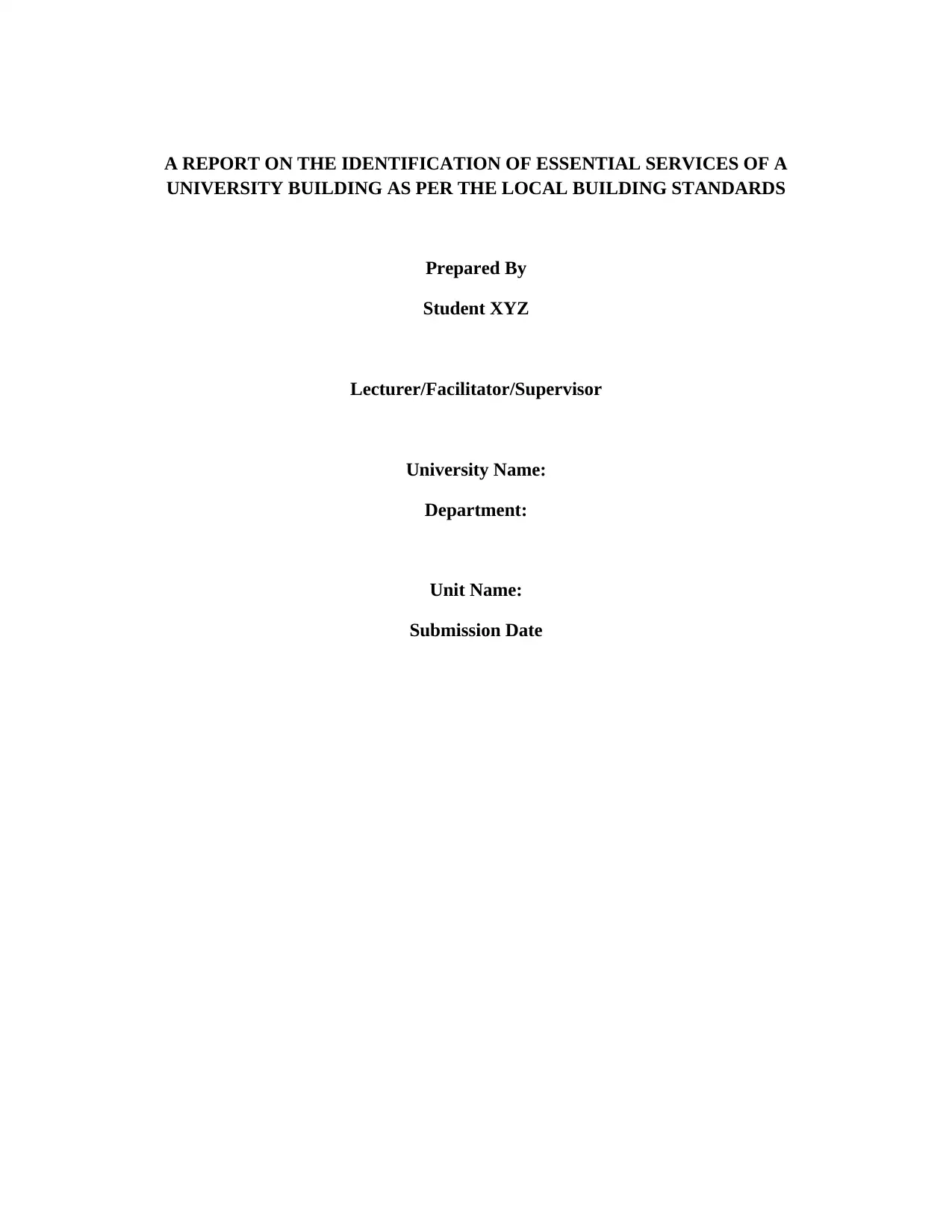
A REPORT ON THE IDENTIFICATION OF ESSENTIAL SERVICES OF A
UNIVERSITY BUILDING AS PER THE LOCAL BUILDING STANDARDS
Prepared By
Student XYZ
Lecturer/Facilitator/Supervisor
University Name:
Department:
Unit Name:
Submission Date
UNIVERSITY BUILDING AS PER THE LOCAL BUILDING STANDARDS
Prepared By
Student XYZ
Lecturer/Facilitator/Supervisor
University Name:
Department:
Unit Name:
Submission Date
Paraphrase This Document
Need a fresh take? Get an instant paraphrase of this document with our AI Paraphraser
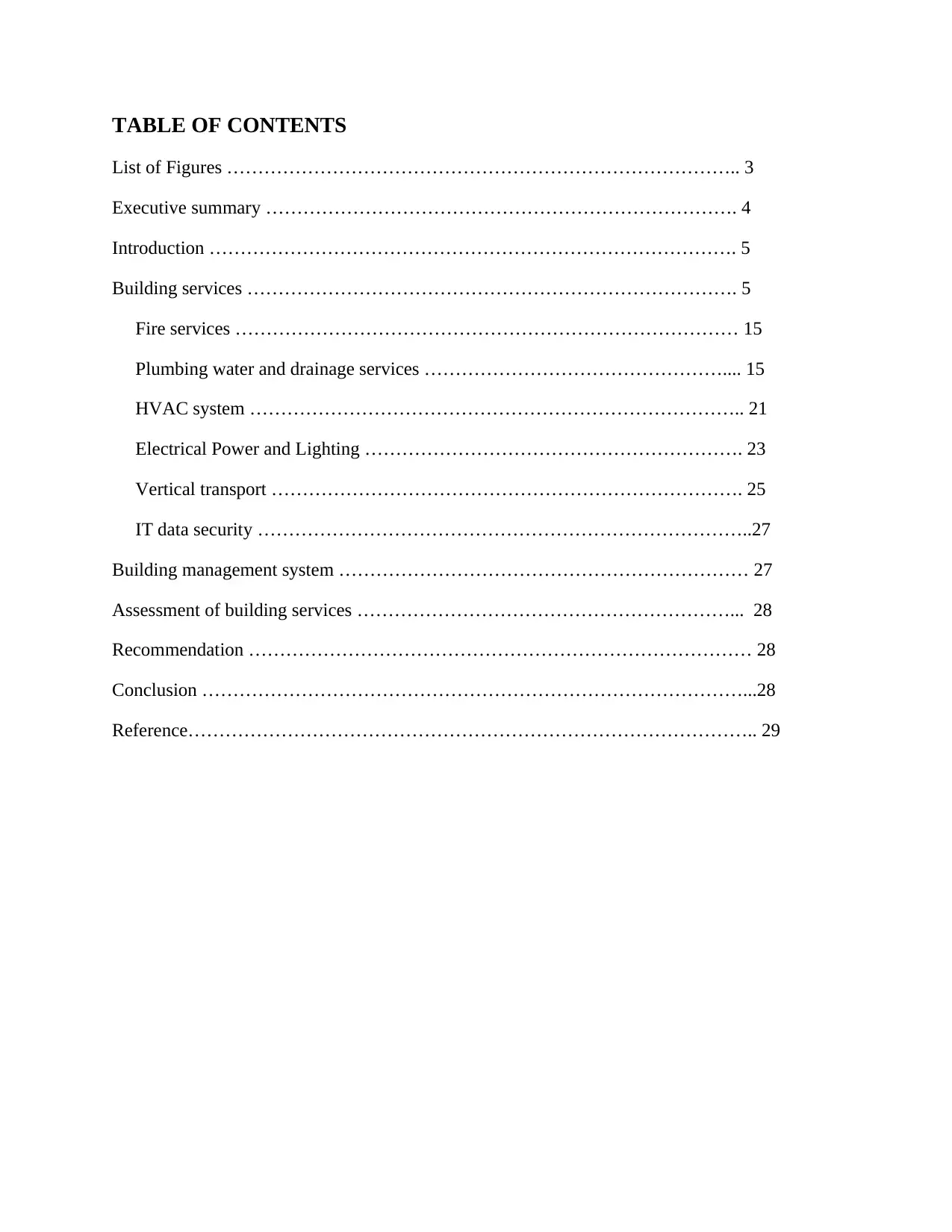
TABLE OF CONTENTS
List of Figures ……………………………………………………………………….. 3
Executive summary …………………………………………………………………. 4
Introduction …………………………………………………………………………. 5
Building services ……………………………………………………………………. 5
Fire services ……………………………………………………………………… 15
Plumbing water and drainage services ………………………………………….... 15
HVAC system …………………………………………………………………….. 21
Electrical Power and Lighting ……………………………………………………. 23
Vertical transport …………………………………………………………………. 25
IT data security ……………………………………………………………………..27
Building management system ………………………………………………………… 27
Assessment of building services ……………………………………………………... 28
Recommendation ……………………………………………………………………… 28
Conclusion ……………………………………………………………………………...28
Reference……………………………………………………………………………….. 29
List of Figures ……………………………………………………………………….. 3
Executive summary …………………………………………………………………. 4
Introduction …………………………………………………………………………. 5
Building services ……………………………………………………………………. 5
Fire services ……………………………………………………………………… 15
Plumbing water and drainage services ………………………………………….... 15
HVAC system …………………………………………………………………….. 21
Electrical Power and Lighting ……………………………………………………. 23
Vertical transport …………………………………………………………………. 25
IT data security ……………………………………………………………………..27
Building management system ………………………………………………………… 27
Assessment of building services ……………………………………………………... 28
Recommendation ……………………………………………………………………… 28
Conclusion ……………………………………………………………………………...28
Reference……………………………………………………………………………….. 29
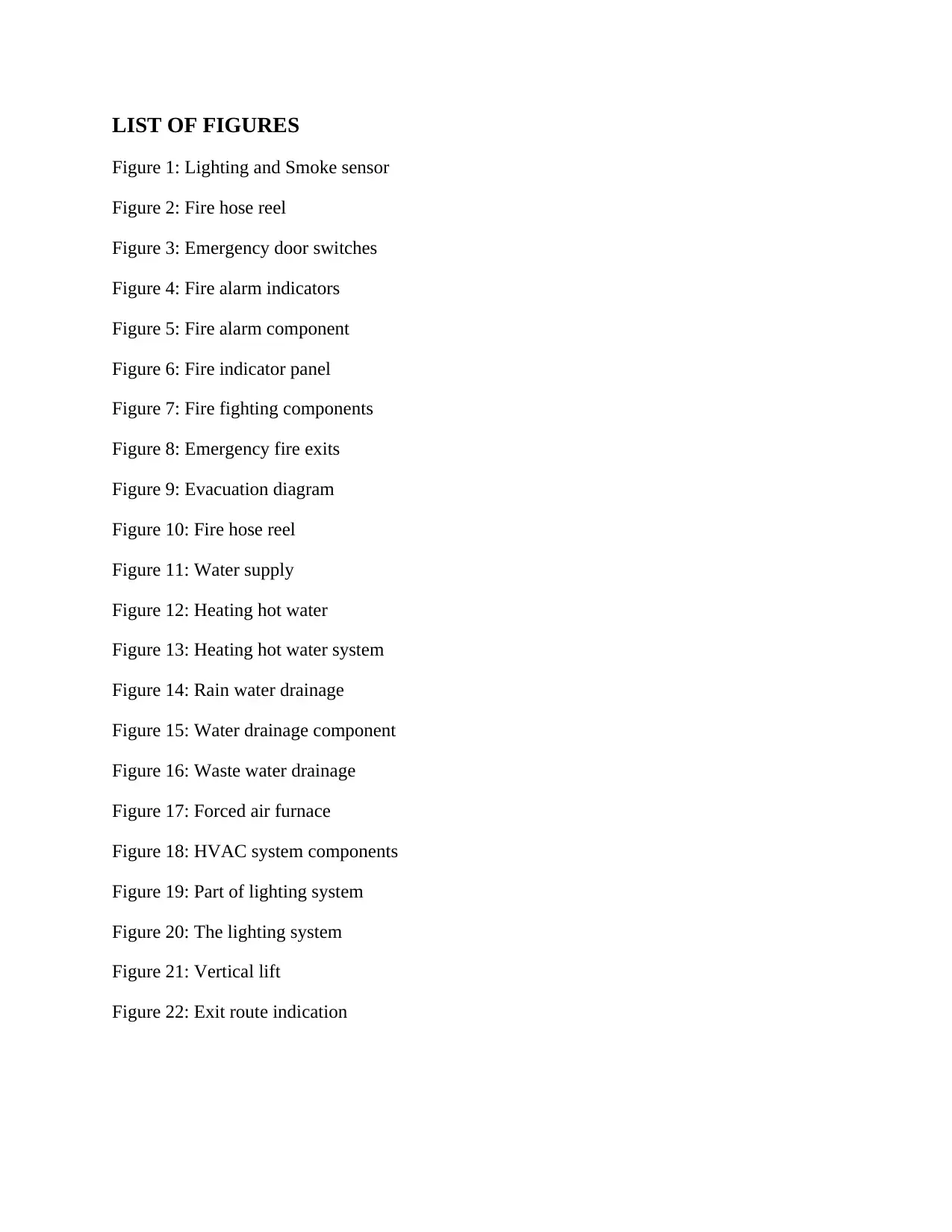
LIST OF FIGURES
Figure 1: Lighting and Smoke sensor
Figure 2: Fire hose reel
Figure 3: Emergency door switches
Figure 4: Fire alarm indicators
Figure 5: Fire alarm component
Figure 6: Fire indicator panel
Figure 7: Fire fighting components
Figure 8: Emergency fire exits
Figure 9: Evacuation diagram
Figure 10: Fire hose reel
Figure 11: Water supply
Figure 12: Heating hot water
Figure 13: Heating hot water system
Figure 14: Rain water drainage
Figure 15: Water drainage component
Figure 16: Waste water drainage
Figure 17: Forced air furnace
Figure 18: HVAC system components
Figure 19: Part of lighting system
Figure 20: The lighting system
Figure 21: Vertical lift
Figure 22: Exit route indication
Figure 1: Lighting and Smoke sensor
Figure 2: Fire hose reel
Figure 3: Emergency door switches
Figure 4: Fire alarm indicators
Figure 5: Fire alarm component
Figure 6: Fire indicator panel
Figure 7: Fire fighting components
Figure 8: Emergency fire exits
Figure 9: Evacuation diagram
Figure 10: Fire hose reel
Figure 11: Water supply
Figure 12: Heating hot water
Figure 13: Heating hot water system
Figure 14: Rain water drainage
Figure 15: Water drainage component
Figure 16: Waste water drainage
Figure 17: Forced air furnace
Figure 18: HVAC system components
Figure 19: Part of lighting system
Figure 20: The lighting system
Figure 21: Vertical lift
Figure 22: Exit route indication
⊘ This is a preview!⊘
Do you want full access?
Subscribe today to unlock all pages.

Trusted by 1+ million students worldwide
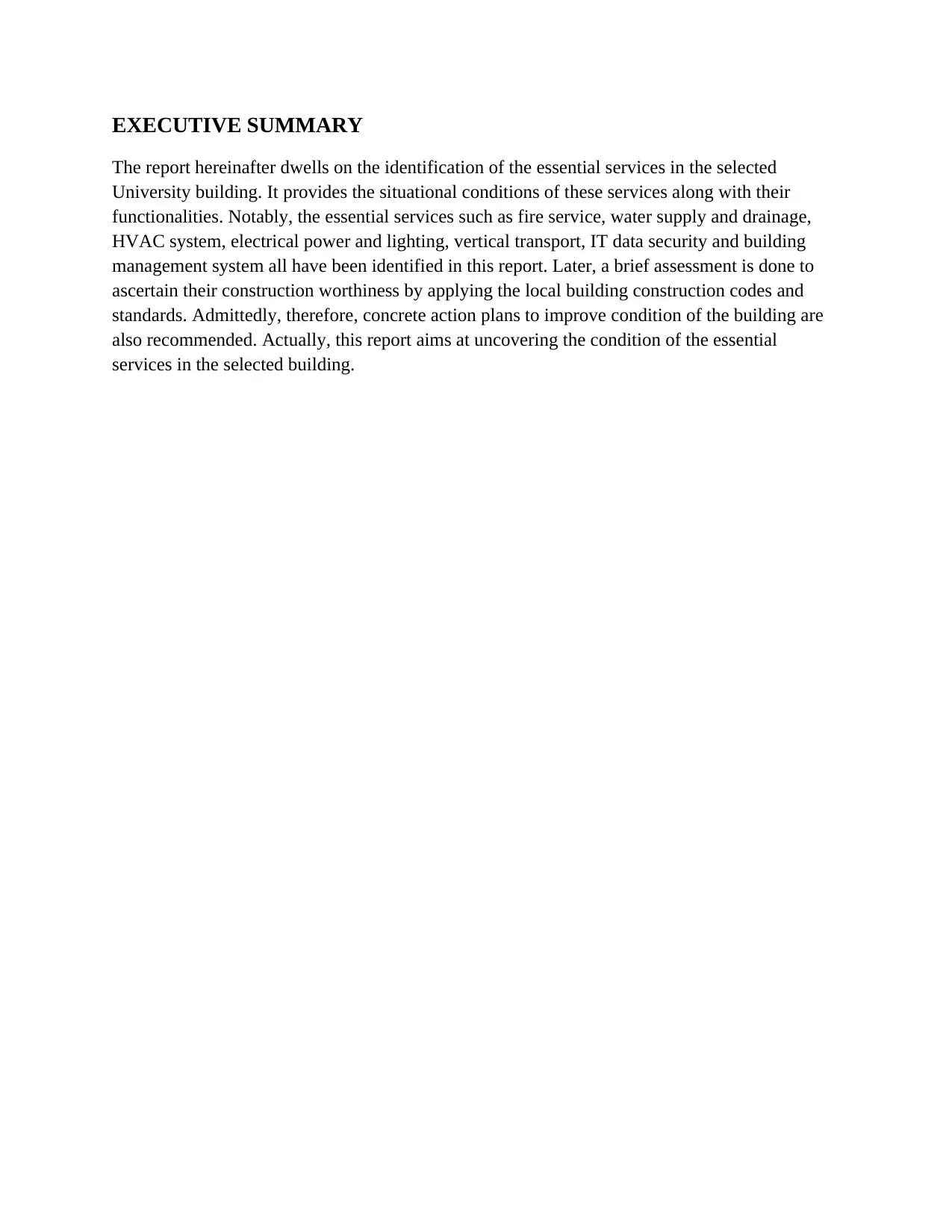
EXECUTIVE SUMMARY
The report hereinafter dwells on the identification of the essential services in the selected
University building. It provides the situational conditions of these services along with their
functionalities. Notably, the essential services such as fire service, water supply and drainage,
HVAC system, electrical power and lighting, vertical transport, IT data security and building
management system all have been identified in this report. Later, a brief assessment is done to
ascertain their construction worthiness by applying the local building construction codes and
standards. Admittedly, therefore, concrete action plans to improve condition of the building are
also recommended. Actually, this report aims at uncovering the condition of the essential
services in the selected building.
The report hereinafter dwells on the identification of the essential services in the selected
University building. It provides the situational conditions of these services along with their
functionalities. Notably, the essential services such as fire service, water supply and drainage,
HVAC system, electrical power and lighting, vertical transport, IT data security and building
management system all have been identified in this report. Later, a brief assessment is done to
ascertain their construction worthiness by applying the local building construction codes and
standards. Admittedly, therefore, concrete action plans to improve condition of the building are
also recommended. Actually, this report aims at uncovering the condition of the essential
services in the selected building.
Paraphrase This Document
Need a fresh take? Get an instant paraphrase of this document with our AI Paraphraser
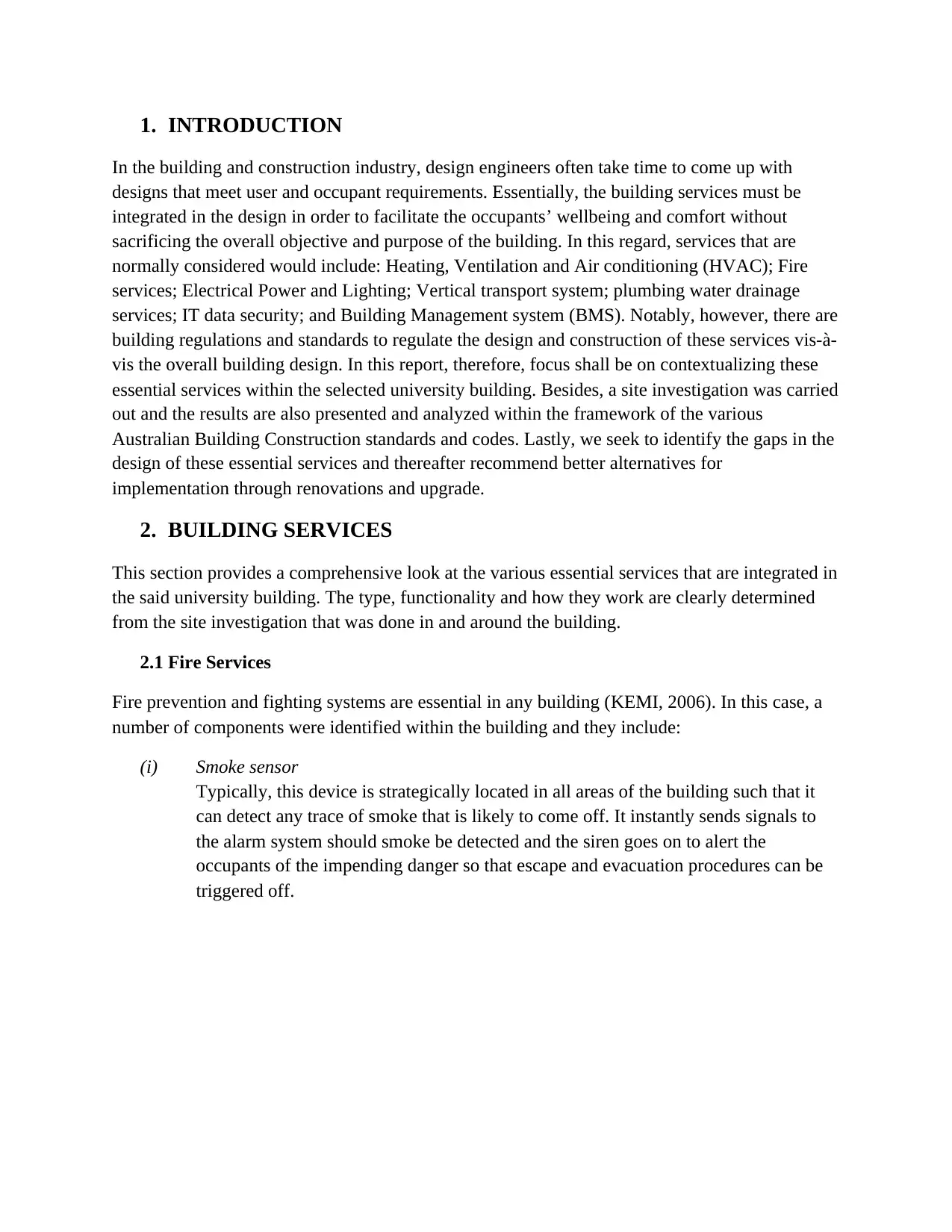
1. INTRODUCTION
In the building and construction industry, design engineers often take time to come up with
designs that meet user and occupant requirements. Essentially, the building services must be
integrated in the design in order to facilitate the occupants’ wellbeing and comfort without
sacrificing the overall objective and purpose of the building. In this regard, services that are
normally considered would include: Heating, Ventilation and Air conditioning (HVAC); Fire
services; Electrical Power and Lighting; Vertical transport system; plumbing water drainage
services; IT data security; and Building Management system (BMS). Notably, however, there are
building regulations and standards to regulate the design and construction of these services vis-à-
vis the overall building design. In this report, therefore, focus shall be on contextualizing these
essential services within the selected university building. Besides, a site investigation was carried
out and the results are also presented and analyzed within the framework of the various
Australian Building Construction standards and codes. Lastly, we seek to identify the gaps in the
design of these essential services and thereafter recommend better alternatives for
implementation through renovations and upgrade.
2. BUILDING SERVICES
This section provides a comprehensive look at the various essential services that are integrated in
the said university building. The type, functionality and how they work are clearly determined
from the site investigation that was done in and around the building.
2.1 Fire Services
Fire prevention and fighting systems are essential in any building (KEMI, 2006). In this case, a
number of components were identified within the building and they include:
(i) Smoke sensor
Typically, this device is strategically located in all areas of the building such that it
can detect any trace of smoke that is likely to come off. It instantly sends signals to
the alarm system should smoke be detected and the siren goes on to alert the
occupants of the impending danger so that escape and evacuation procedures can be
triggered off.
In the building and construction industry, design engineers often take time to come up with
designs that meet user and occupant requirements. Essentially, the building services must be
integrated in the design in order to facilitate the occupants’ wellbeing and comfort without
sacrificing the overall objective and purpose of the building. In this regard, services that are
normally considered would include: Heating, Ventilation and Air conditioning (HVAC); Fire
services; Electrical Power and Lighting; Vertical transport system; plumbing water drainage
services; IT data security; and Building Management system (BMS). Notably, however, there are
building regulations and standards to regulate the design and construction of these services vis-à-
vis the overall building design. In this report, therefore, focus shall be on contextualizing these
essential services within the selected university building. Besides, a site investigation was carried
out and the results are also presented and analyzed within the framework of the various
Australian Building Construction standards and codes. Lastly, we seek to identify the gaps in the
design of these essential services and thereafter recommend better alternatives for
implementation through renovations and upgrade.
2. BUILDING SERVICES
This section provides a comprehensive look at the various essential services that are integrated in
the said university building. The type, functionality and how they work are clearly determined
from the site investigation that was done in and around the building.
2.1 Fire Services
Fire prevention and fighting systems are essential in any building (KEMI, 2006). In this case, a
number of components were identified within the building and they include:
(i) Smoke sensor
Typically, this device is strategically located in all areas of the building such that it
can detect any trace of smoke that is likely to come off. It instantly sends signals to
the alarm system should smoke be detected and the siren goes on to alert the
occupants of the impending danger so that escape and evacuation procedures can be
triggered off.
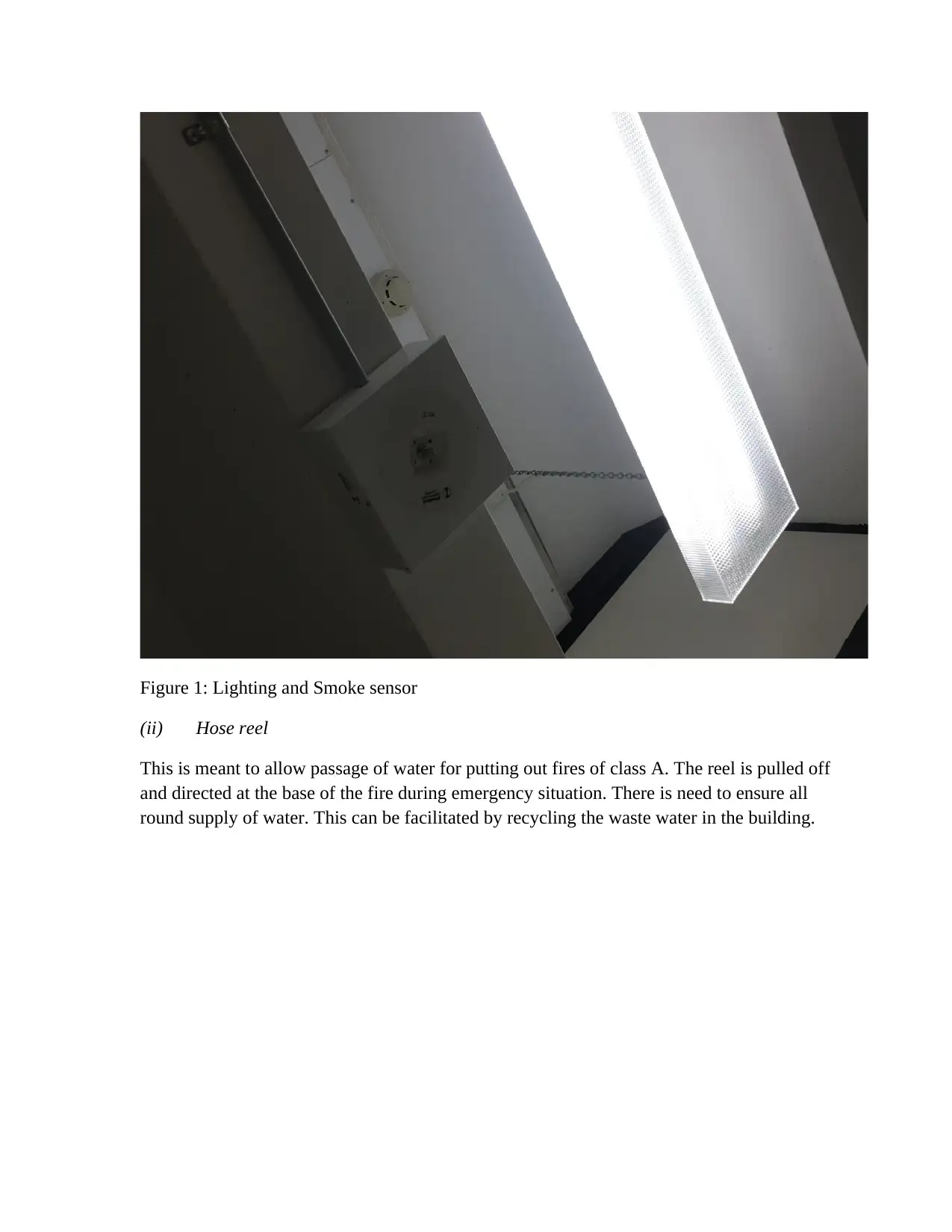
Figure 1: Lighting and Smoke sensor
(ii) Hose reel
This is meant to allow passage of water for putting out fires of class A. The reel is pulled off
and directed at the base of the fire during emergency situation. There is need to ensure all
round supply of water. This can be facilitated by recycling the waste water in the building.
(ii) Hose reel
This is meant to allow passage of water for putting out fires of class A. The reel is pulled off
and directed at the base of the fire during emergency situation. There is need to ensure all
round supply of water. This can be facilitated by recycling the waste water in the building.
⊘ This is a preview!⊘
Do you want full access?
Subscribe today to unlock all pages.

Trusted by 1+ million students worldwide
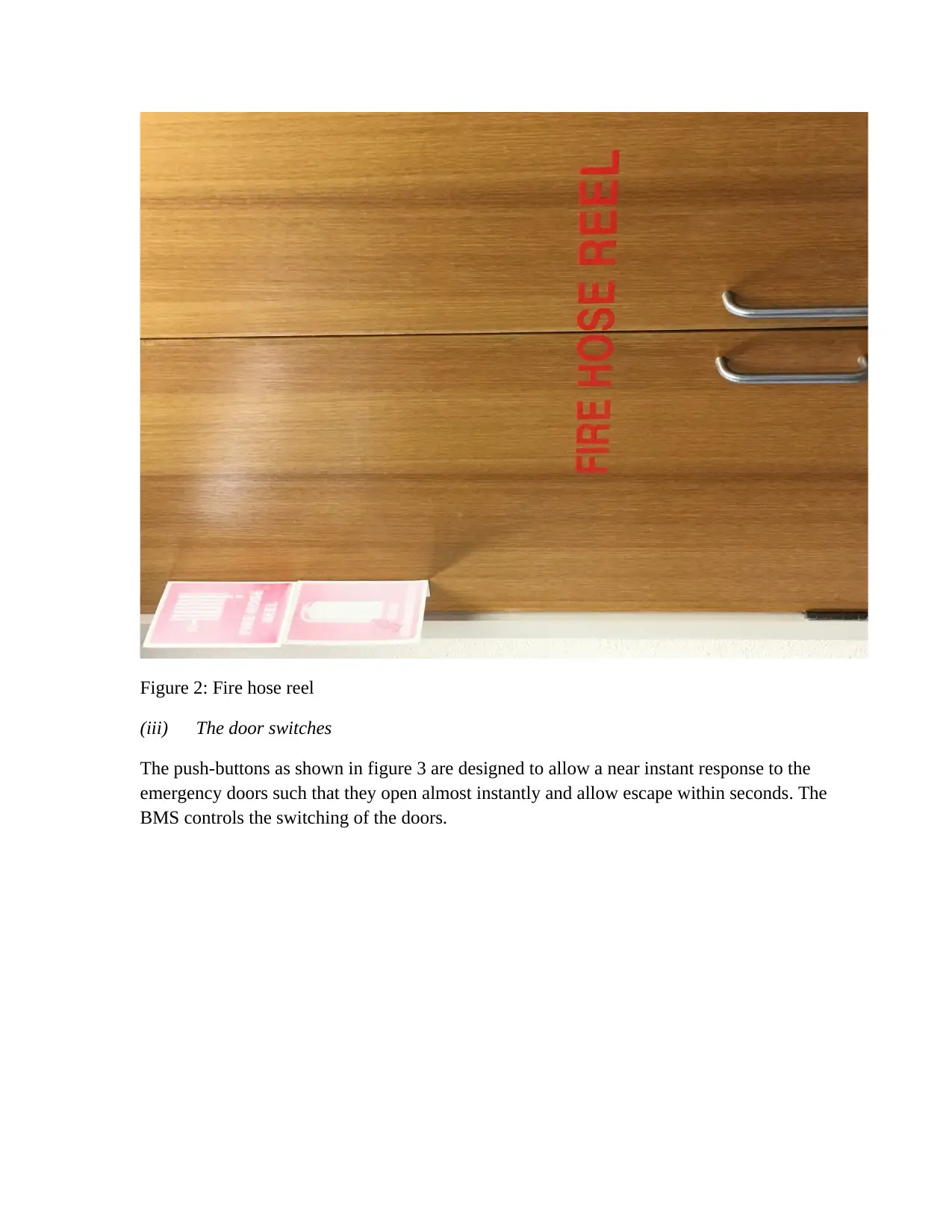
Figure 2: Fire hose reel
(iii) The door switches
The push-buttons as shown in figure 3 are designed to allow a near instant response to the
emergency doors such that they open almost instantly and allow escape within seconds. The
BMS controls the switching of the doors.
(iii) The door switches
The push-buttons as shown in figure 3 are designed to allow a near instant response to the
emergency doors such that they open almost instantly and allow escape within seconds. The
BMS controls the switching of the doors.
Paraphrase This Document
Need a fresh take? Get an instant paraphrase of this document with our AI Paraphraser
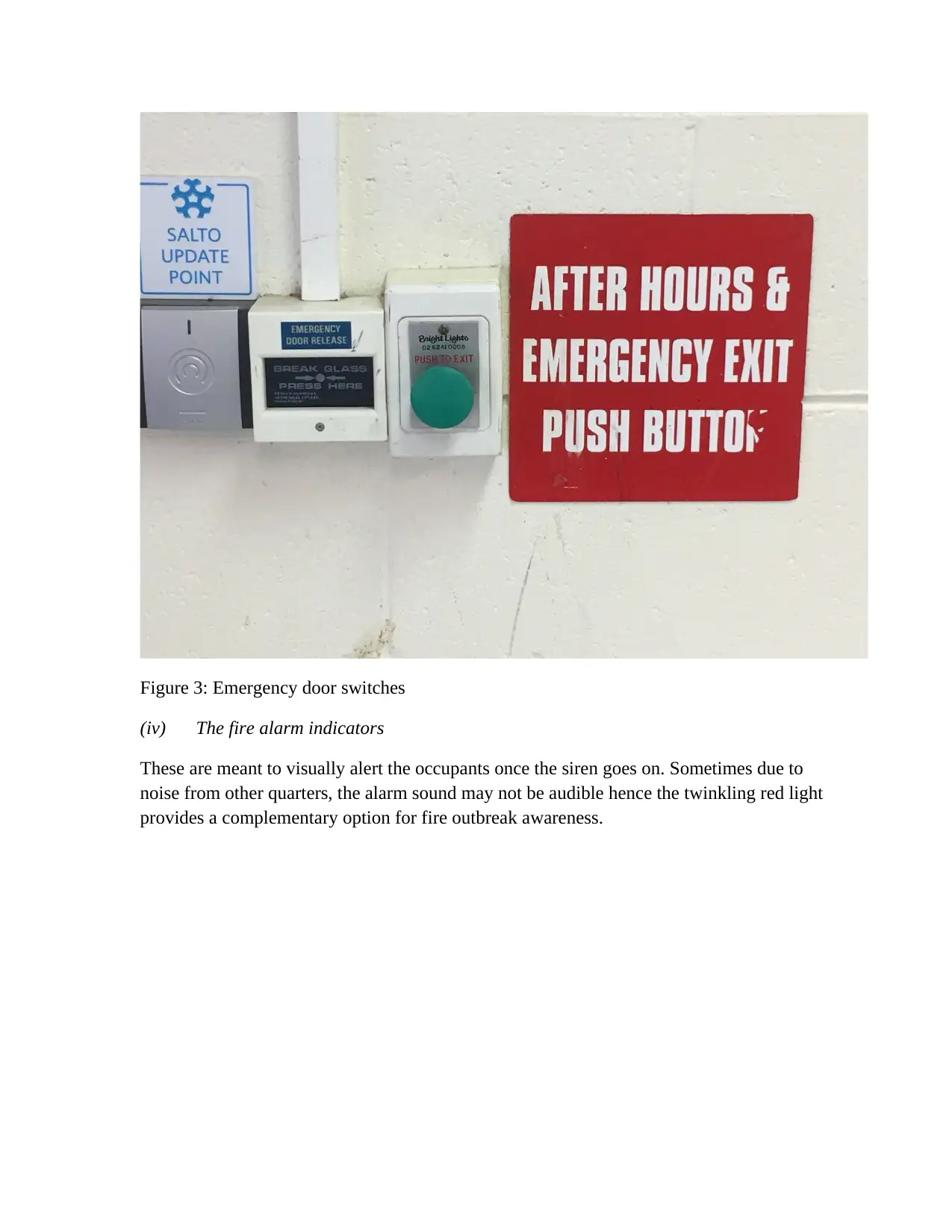
Figure 3: Emergency door switches
(iv) The fire alarm indicators
These are meant to visually alert the occupants once the siren goes on. Sometimes due to
noise from other quarters, the alarm sound may not be audible hence the twinkling red light
provides a complementary option for fire outbreak awareness.
(iv) The fire alarm indicators
These are meant to visually alert the occupants once the siren goes on. Sometimes due to
noise from other quarters, the alarm sound may not be audible hence the twinkling red light
provides a complementary option for fire outbreak awareness.
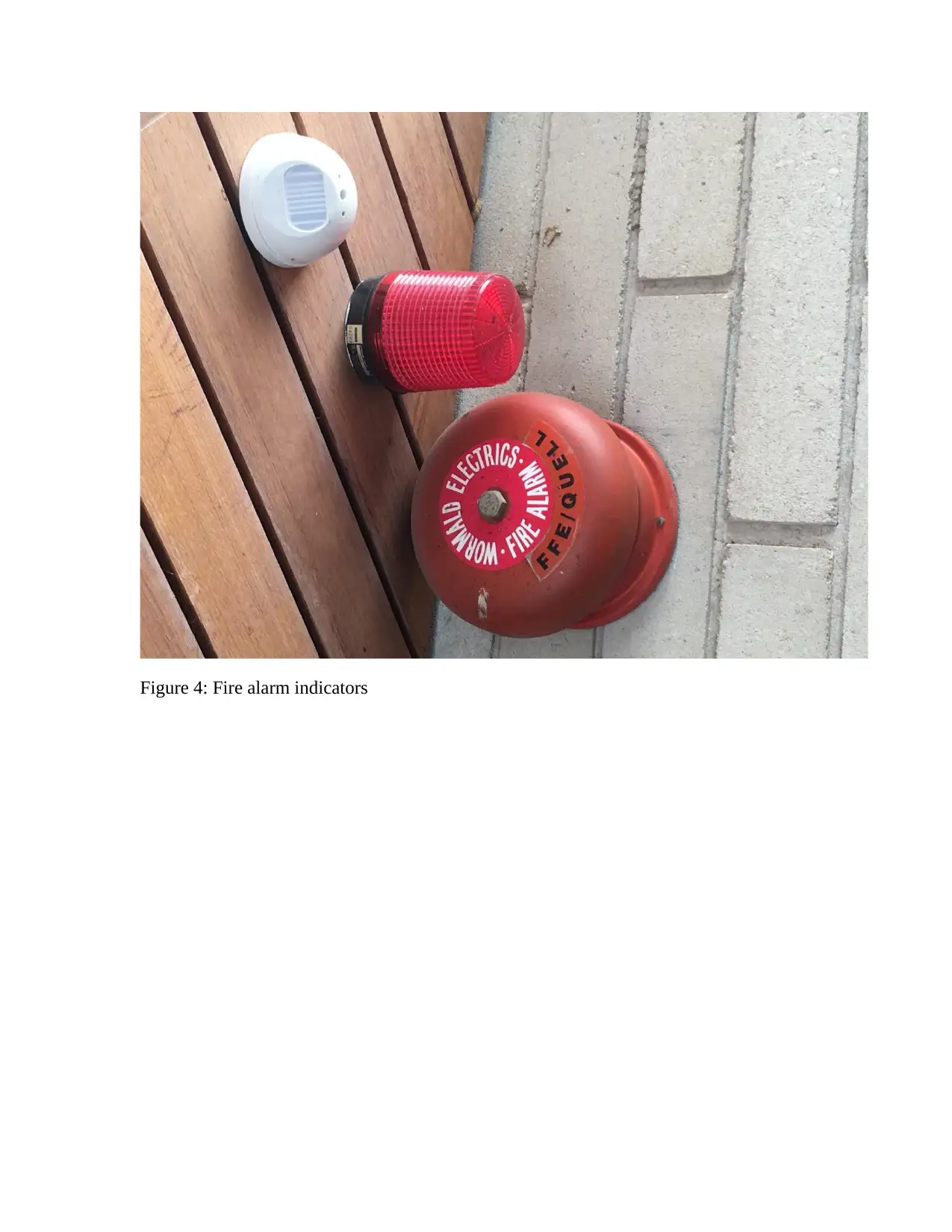
Figure 4: Fire alarm indicators
⊘ This is a preview!⊘
Do you want full access?
Subscribe today to unlock all pages.

Trusted by 1+ million students worldwide
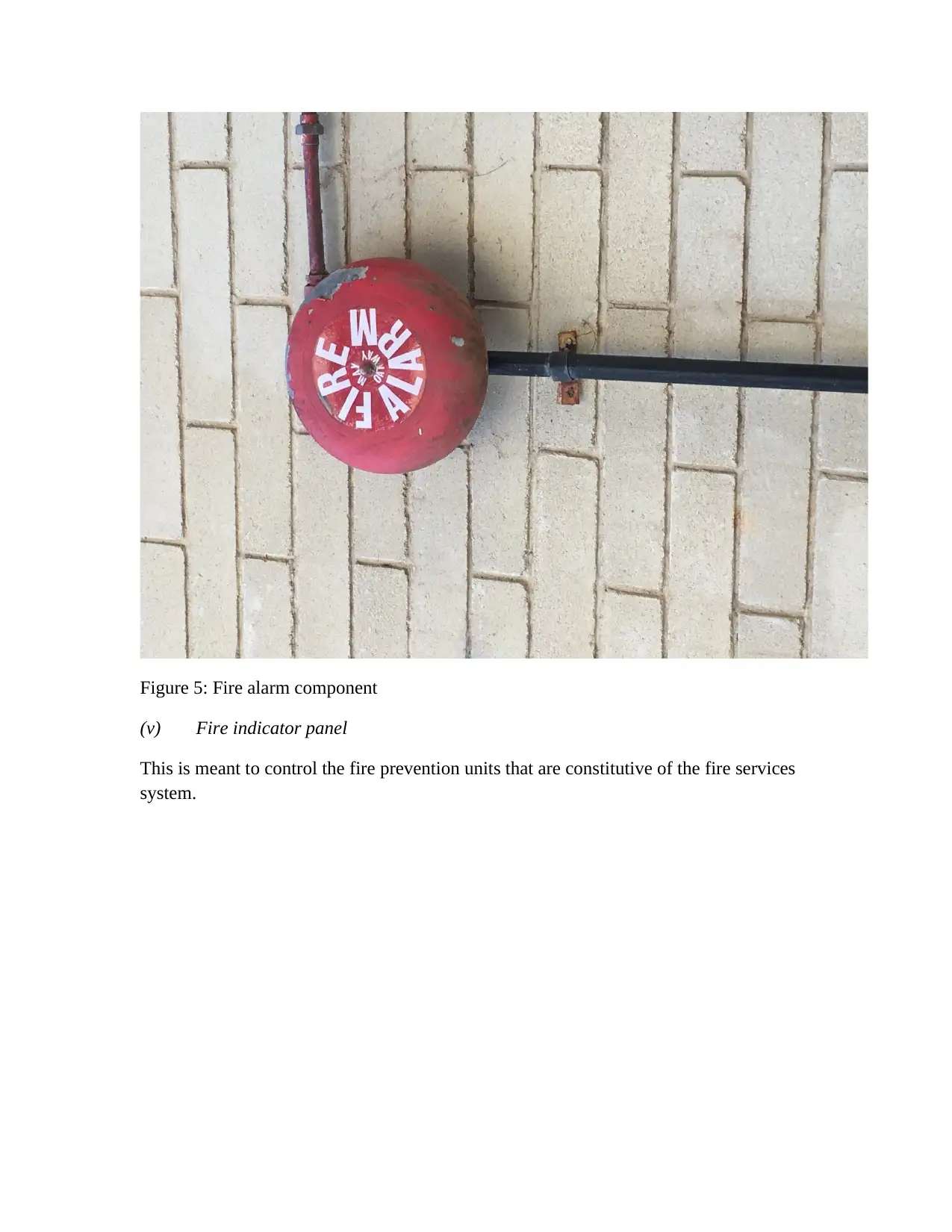
Figure 5: Fire alarm component
(v) Fire indicator panel
This is meant to control the fire prevention units that are constitutive of the fire services
system.
(v) Fire indicator panel
This is meant to control the fire prevention units that are constitutive of the fire services
system.
Paraphrase This Document
Need a fresh take? Get an instant paraphrase of this document with our AI Paraphraser
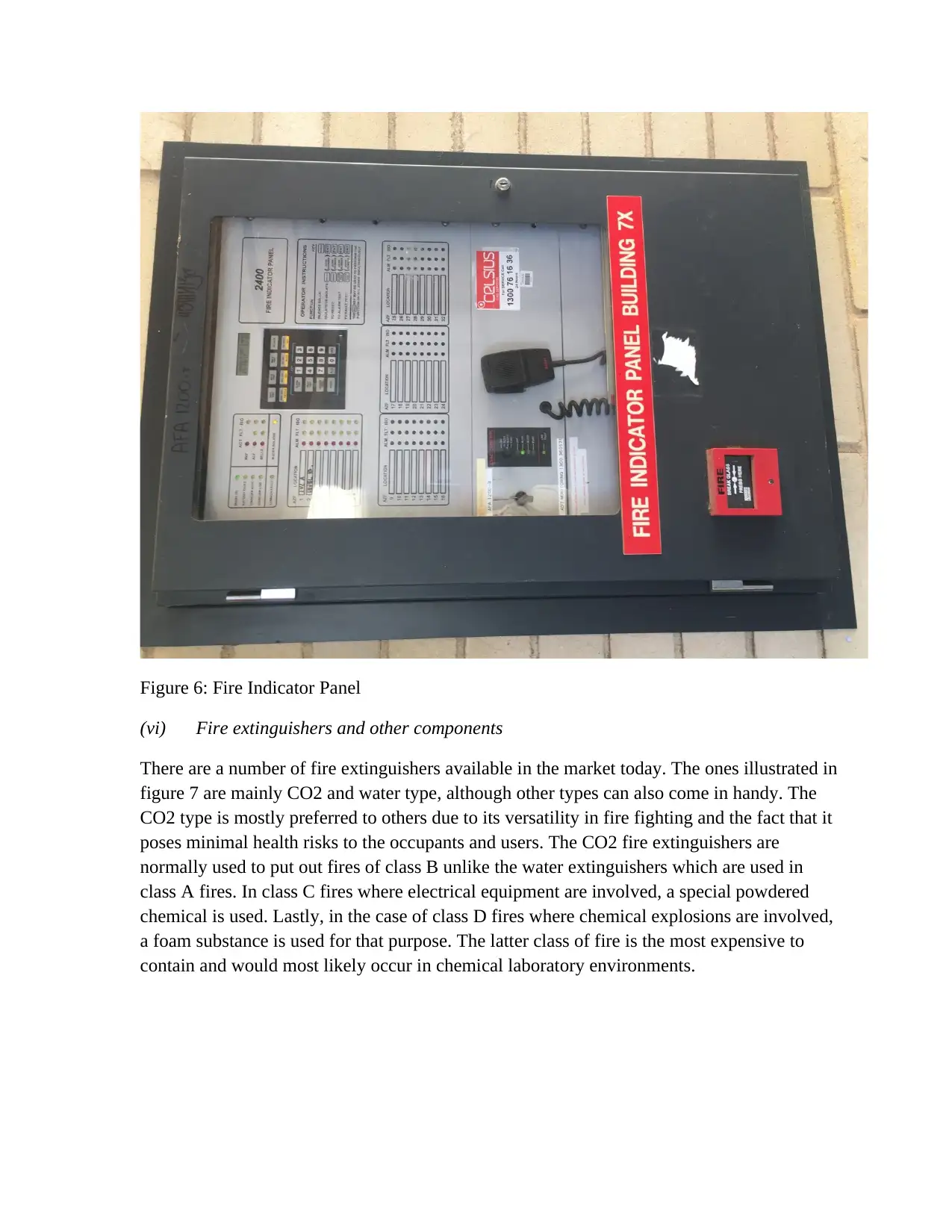
Figure 6: Fire Indicator Panel
(vi) Fire extinguishers and other components
There are a number of fire extinguishers available in the market today. The ones illustrated in
figure 7 are mainly CO2 and water type, although other types can also come in handy. The
CO2 type is mostly preferred to others due to its versatility in fire fighting and the fact that it
poses minimal health risks to the occupants and users. The CO2 fire extinguishers are
normally used to put out fires of class B unlike the water extinguishers which are used in
class A fires. In class C fires where electrical equipment are involved, a special powdered
chemical is used. Lastly, in the case of class D fires where chemical explosions are involved,
a foam substance is used for that purpose. The latter class of fire is the most expensive to
contain and would most likely occur in chemical laboratory environments.
(vi) Fire extinguishers and other components
There are a number of fire extinguishers available in the market today. The ones illustrated in
figure 7 are mainly CO2 and water type, although other types can also come in handy. The
CO2 type is mostly preferred to others due to its versatility in fire fighting and the fact that it
poses minimal health risks to the occupants and users. The CO2 fire extinguishers are
normally used to put out fires of class B unlike the water extinguishers which are used in
class A fires. In class C fires where electrical equipment are involved, a special powdered
chemical is used. Lastly, in the case of class D fires where chemical explosions are involved,
a foam substance is used for that purpose. The latter class of fire is the most expensive to
contain and would most likely occur in chemical laboratory environments.
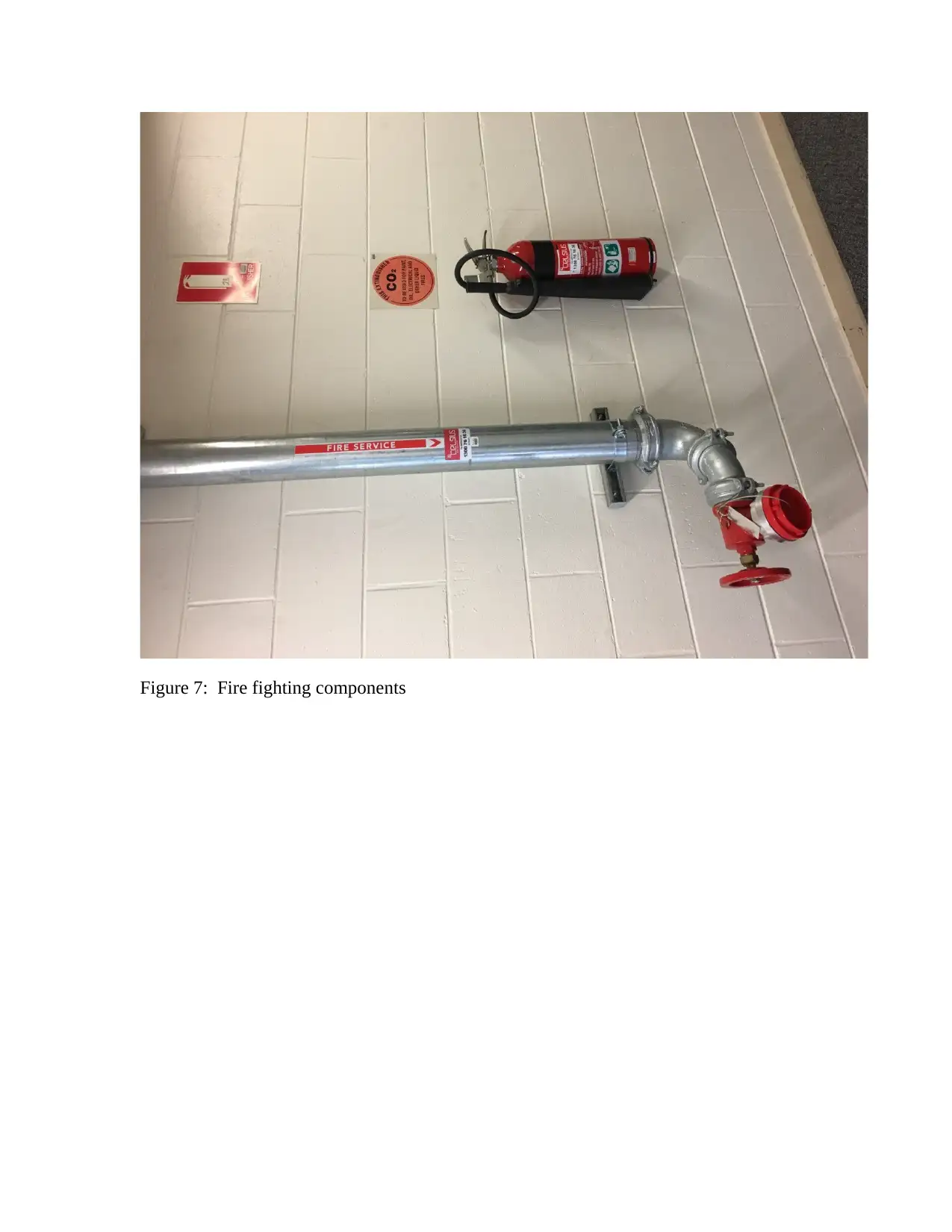
Figure 7: Fire fighting components
⊘ This is a preview!⊘
Do you want full access?
Subscribe today to unlock all pages.

Trusted by 1+ million students worldwide
1 out of 30
Related Documents
Your All-in-One AI-Powered Toolkit for Academic Success.
+13062052269
info@desklib.com
Available 24*7 on WhatsApp / Email
![[object Object]](/_next/static/media/star-bottom.7253800d.svg)
Unlock your academic potential
Copyright © 2020–2025 A2Z Services. All Rights Reserved. Developed and managed by ZUCOL.




